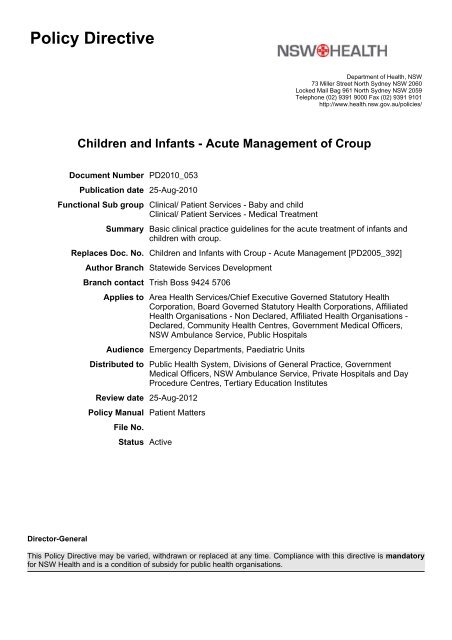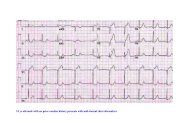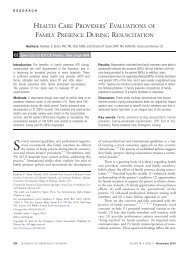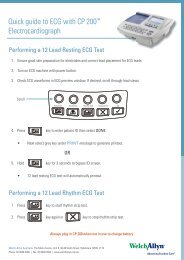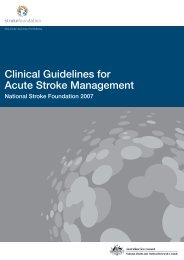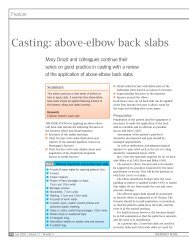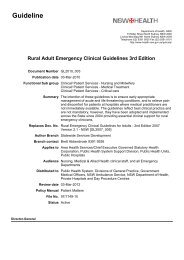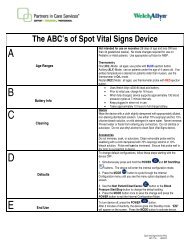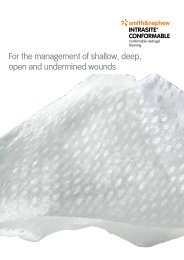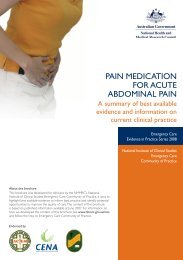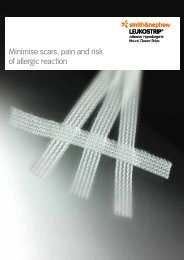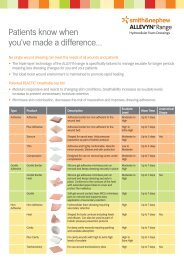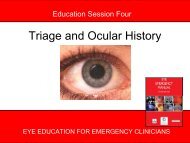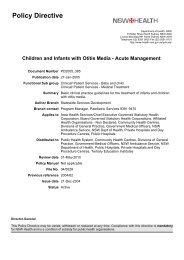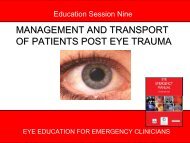Infants and children with croup - Living on the EDge
Infants and children with croup - Living on the EDge
Infants and children with croup - Living on the EDge
Create successful ePaper yourself
Turn your PDF publications into a flip-book with our unique Google optimized e-Paper software.
Policy Directive<br />
Department of Health, NSW<br />
73 Miller Street North Sydney NSW 2060<br />
Locked Mail Bag 961 North Sydney NSW 2059<br />
Teleph<strong>on</strong>e (02) 9391 9000 Fax (02) 9391 9101<br />
http://www.health.nsw.gov.au/policies/<br />
Children <str<strong>on</strong>g>and</str<strong>on</strong>g> <str<strong>on</strong>g>Infants</str<strong>on</strong>g> - Acute Management of Croup<br />
Document Number PD2010_053<br />
Publicati<strong>on</strong> date 25-Aug-2010<br />
Functi<strong>on</strong>al Sub group Clinical/ Patient Services - Baby <str<strong>on</strong>g>and</str<strong>on</strong>g> child<br />
Clinical/ Patient Services - Medical Treatment<br />
Summary Basic clinical practice guidelines for <strong>the</strong> acute treatment of infants <str<strong>on</strong>g>and</str<strong>on</strong>g><br />
<str<strong>on</strong>g>children</str<strong>on</strong>g> <str<strong>on</strong>g>with</str<strong>on</strong>g> <str<strong>on</strong>g>croup</str<strong>on</strong>g>.<br />
Replaces Doc. No. Children <str<strong>on</strong>g>and</str<strong>on</strong>g> <str<strong>on</strong>g>Infants</str<strong>on</strong>g> <str<strong>on</strong>g>with</str<strong>on</strong>g> Croup - Acute Management [PD2005_392]<br />
Author Branch Statewide Services Development<br />
Branch c<strong>on</strong>tact Trish Boss 9424 5706<br />
Applies to Area Health Services/Chief Executive Governed Statutory Health<br />
Corporati<strong>on</strong>, Board Governed Statutory Health Corporati<strong>on</strong>s, Affiliated<br />
Health Organisati<strong>on</strong>s - N<strong>on</strong> Declared, Affiliated Health Organisati<strong>on</strong>s -<br />
Declared, Community Health Centres, Government Medical Officers,<br />
NSW Ambulance Service, Public Hospitals<br />
Audience Emergency Departments, Paediatric Units<br />
Distributed to Public Health System, Divisi<strong>on</strong>s of General Practice, Government<br />
Medical Officers, NSW Ambulance Service, Private Hospitals <str<strong>on</strong>g>and</str<strong>on</strong>g> Day<br />
Procedure Centres, Tertiary Educati<strong>on</strong> Institutes<br />
Review date 25-Aug-2012<br />
Policy Manual Patient Matters<br />
File No.<br />
Status Active<br />
space<br />
space<br />
space<br />
Director-General<br />
space<br />
This Policy Directive may be varied, <str<strong>on</strong>g>with</str<strong>on</strong>g>drawn or replaced at any time. Compliance <str<strong>on</strong>g>with</str<strong>on</strong>g> this directive is m<str<strong>on</strong>g>and</str<strong>on</strong>g>atory<br />
for NSW Health <str<strong>on</strong>g>and</str<strong>on</strong>g> is a c<strong>on</strong>diti<strong>on</strong> of subsidy for public health organisati<strong>on</strong>s.
POLICY STATEMENT<br />
INFANTS AND CHILDREN: ACUTE MANAGEMENT OF CROUP<br />
PURPOSE<br />
The infants <str<strong>on</strong>g>and</str<strong>on</strong>g> <str<strong>on</strong>g>children</str<strong>on</strong>g>: acute management of <str<strong>on</strong>g>croup</str<strong>on</strong>g> clinical practice guideline<br />
(attached) has been developed to provide directi<strong>on</strong> to clinicians <str<strong>on</strong>g>and</str<strong>on</strong>g> is aimed at<br />
achieving <strong>the</strong> best possible paediatric care in all parts of <strong>the</strong> state.<br />
The clinical practice guideline was prepared for <strong>the</strong> NSW Department of Health by an<br />
expert clinical reference group under <strong>the</strong> auspice of <strong>the</strong> state wide Paediatric Clinical<br />
Practice Guideline Steering Group.<br />
MANDATORY REQUIREMENTS<br />
This policy applies to all facilities where paediatric patients are managed. It requires all<br />
Health Services to have local guidelines/protocols based <strong>on</strong> <strong>the</strong> attached clinical<br />
practice guideline in place in all hospitals <str<strong>on</strong>g>and</str<strong>on</strong>g> facilities likely to be required to assess or<br />
manage <str<strong>on</strong>g>children</str<strong>on</strong>g> <str<strong>on</strong>g>with</str<strong>on</strong>g> <str<strong>on</strong>g>croup</str<strong>on</strong>g>.<br />
The clinical practice guideline reflects what is currently regarded as a safe <str<strong>on</strong>g>and</str<strong>on</strong>g><br />
appropriate approach to <strong>the</strong> acute management of <str<strong>on</strong>g>croup</str<strong>on</strong>g> in infants <str<strong>on</strong>g>and</str<strong>on</strong>g> <str<strong>on</strong>g>children</str<strong>on</strong>g>.<br />
However, as in any clinical situati<strong>on</strong> <strong>the</strong>re may be factors which cannot be covered by a<br />
single set of guidelines. This document should be used as a guide, ra<strong>the</strong>r than as a<br />
complete authoritative statement of procedures to be followed in respect of each<br />
individual presentati<strong>on</strong>. It does not replace <strong>the</strong> need for <strong>the</strong> applicati<strong>on</strong> of clinical<br />
judgement to each individual presentati<strong>on</strong>.<br />
IMPLEMENTATION<br />
Chief Executives must ensure:<br />
• Local protocols are developed based <strong>on</strong> <strong>the</strong> infants <str<strong>on</strong>g>and</str<strong>on</strong>g> <str<strong>on</strong>g>children</str<strong>on</strong>g>: acute<br />
management of <str<strong>on</strong>g>croup</str<strong>on</strong>g> clinical practice guideline.<br />
• Local protocols are in place in all hospitals <str<strong>on</strong>g>and</str<strong>on</strong>g> facilities likely to be required to<br />
assess or manage paediatric patients <str<strong>on</strong>g>with</str<strong>on</strong>g> <str<strong>on</strong>g>croup</str<strong>on</strong>g>.<br />
• Ensure that all staff treating paediatric patients are educated in <strong>the</strong> use of <strong>the</strong><br />
locally developed paediatric protocols.<br />
Directors of Clinical Governance are required to inform relevant clinical staff treating<br />
paediatric patients of <strong>the</strong> revised protocols.<br />
REVISION HISTORY<br />
Versi<strong>on</strong> Approved by Amendment notes<br />
December 2004 Director-General<br />
New policy<br />
(PD2005_392)<br />
August 2010<br />
(PD2010_053)<br />
Deputy Director-General<br />
Populati<strong>on</strong> Health<br />
Rescinds PD2005_392. Sec<strong>on</strong>d editi<strong>on</strong> of <strong>the</strong> clinical<br />
practice guidelines.<br />
ATTACHMENT<br />
1. <str<strong>on</strong>g>Infants</str<strong>on</strong>g> <str<strong>on</strong>g>and</str<strong>on</strong>g> Children: Acute Management of Croup – Clinical Practice Guideline.<br />
PD2010_053 Issue date: August 2010 Page 1 of 1
<str<strong>on</strong>g>Infants</str<strong>on</strong>g> <str<strong>on</strong>g>and</str<strong>on</strong>g> Children:<br />
Acute Management of Croup<br />
sec<strong>on</strong>d editi<strong>on</strong><br />
CLINICAL PRACTICE GUIDELINES
NSW DEPARTMENT OF HEALTH<br />
73 Miller Street<br />
North Sydney NSW 2060<br />
Tel. (02) 9391 9000<br />
Fax. (02) 9391 9101<br />
www.health.nsw.gov.au<br />
This work is copyright. It may be reproduced in whole or part for study or training<br />
purposes subject to <strong>the</strong> inclusi<strong>on</strong> of an acknowledgement of <strong>the</strong> source. It may not be<br />
reproduced for commercial usage or sale. Reproducti<strong>on</strong> for purposes o<strong>the</strong>r than those<br />
indicated above requires written permissi<strong>on</strong> from <strong>the</strong> NSW Department of Health.<br />
This Clinical Practice Guideline booklet is extracted from <strong>the</strong> PD2010_053 <str<strong>on</strong>g>and</str<strong>on</strong>g> as a<br />
result, this booklet may be varied, <str<strong>on</strong>g>with</str<strong>on</strong>g>drawn or replaced at any time. Compliance <str<strong>on</strong>g>with</str<strong>on</strong>g><br />
<strong>the</strong> informati<strong>on</strong> in this booklet is m<str<strong>on</strong>g>and</str<strong>on</strong>g>atory for NSW Health.<br />
© NSW Department of Health 2010<br />
SHPN (SSD) 100062<br />
ISBN 978-1-74187-541-6<br />
For fur<strong>the</strong>r copies of this document please c<strong>on</strong>tact:<br />
Better Health Centre – Publicati<strong>on</strong>s Warehouse<br />
PO Box 672<br />
North Ryde BC, NSW 2113<br />
Tel. (02) 9887 5450<br />
Fax. (02) 9887 5452<br />
Email. bhc@nsccahs.nsw.gov.au<br />
Informati<strong>on</strong> Producti<strong>on</strong> <str<strong>on</strong>g>and</str<strong>on</strong>g> Distributi<strong>on</strong><br />
Tel. (02) 9391 9470<br />
Fur<strong>the</strong>r copies of this document can be downloaded<br />
from <strong>the</strong> NSW Health website: www.health.nsw.gov.au<br />
A revisi<strong>on</strong> of this document is due in 2012.<br />
August 2010 - sec<strong>on</strong>d editi<strong>on</strong>
C<strong>on</strong>tents<br />
Introducti<strong>on</strong>................................................................................................. 3<br />
Changes from Previous Clinical Practice Guideline................................. 4<br />
Overview...................................................................................................... 5<br />
What is Croup?........................................................................................... 5<br />
What is not Croup?..................................................................................... 5<br />
Distinguishing Viral from Spasmodic Croup............................................. 6<br />
Assessment of Severity.............................................................................. 6<br />
Assessing <strong>the</strong> Need for Treatment......................................................................... 7<br />
Factors Increasing Likelihood of Hospital Admissi<strong>on</strong>.............................. 7<br />
Mild Airway Obstructi<strong>on</strong>............................................................................. 7<br />
Moderate Airway Obstructi<strong>on</strong>.................................................................... 7<br />
Progressi<strong>on</strong> from Moderate to Severe Airway Obstructi<strong>on</strong>..................... 8<br />
Severe Airway Obstructi<strong>on</strong>........................................................................ 8<br />
Oximetry...................................................................................................... 8<br />
Clinical Scoring Systems........................................................................... 8<br />
Lateral Airways X-ray................................................................................. 9<br />
Chest Radiograph (CXR)............................................................................ 9<br />
Which Treatment is Appropriate?.............................................................. 9<br />
NSW Health <str<strong>on</strong>g>Infants</str<strong>on</strong>g> <str<strong>on</strong>g>and</str<strong>on</strong>g> Children – Acute Management of Croup PAGE 1
Evidence Based Treatment Opti<strong>on</strong>s.......................................................... 9<br />
N<strong>on</strong> Pharmacological: Steam Inhalati<strong>on</strong>................................................................. 9<br />
Oxygen............................................................................................................... 10<br />
Systemic Corticosteroids...................................................................................... 10<br />
Nebulised Adrenaline.......................................................................................... 11<br />
Inhaled Corticosteroids........................................................................................ 12<br />
Summary of Evidence Based Treatment Opti<strong>on</strong>s....................................12<br />
Causes of Upper Airway Obstructi<strong>on</strong> (Table 1)........................................13<br />
Evidence Base of Recommendati<strong>on</strong>s (Table 2).......................................13<br />
Pharmacological Treatment of Croup .<br />
in <strong>the</strong> Emergency Department (Table 3)...................................................15<br />
Summary of Croup Management.............................................................14<br />
Diagnosis............................................................................................................ 14<br />
Assessment......................................................................................................... 14<br />
Treatment........................................................................................................... 14<br />
Likelihood of Admissi<strong>on</strong> to Hospital..................................................................... 16<br />
C<strong>on</strong>siderati<strong>on</strong>s for Transfer to Paediatric Hospital................................................ 16<br />
Clinical Assessment Stridor/Respiratory Distress .<br />
Flow Diagram (Figure 1).............................................................................17<br />
Appendices................................................................................................18<br />
Appendix 1: References....................................................................................... 18<br />
Appendix 2: Parent Informati<strong>on</strong>.......................................................................... 20<br />
Appendix 3: Resources........................................................................................ 20<br />
Appendix 4: Working Party members.................................................................. 21<br />
PAGE 2<br />
NSW Health <str<strong>on</strong>g>Infants</str<strong>on</strong>g> <str<strong>on</strong>g>and</str<strong>on</strong>g> Children – Acute Management of Croup
Introducti<strong>on</strong><br />
These Guidelines are aimed at achieving<br />
<strong>the</strong> best possible paediatric care in all<br />
parts of <strong>the</strong> State. The document should<br />
not be seen as a stringent set of rules<br />
to be applied <str<strong>on</strong>g>with</str<strong>on</strong>g>out <strong>the</strong> clinical input<br />
<str<strong>on</strong>g>and</str<strong>on</strong>g> discreti<strong>on</strong> of <strong>the</strong> managing<br />
professi<strong>on</strong>als. Each patient should be<br />
individually evaluated <str<strong>on</strong>g>and</str<strong>on</strong>g> a decisi<strong>on</strong> made<br />
as to appropriate management in order<br />
to achieve <strong>the</strong> best clinical outcome.<br />
The formal definiti<strong>on</strong> of clinical practice<br />
guidelines comes from <strong>the</strong> Nati<strong>on</strong>al<br />
|Health <str<strong>on</strong>g>and</str<strong>on</strong>g> Medical Research Council:<br />
‘systematically developed statements to<br />
assist practiti<strong>on</strong>er <str<strong>on</strong>g>and</str<strong>on</strong>g> patient decisi<strong>on</strong>s<br />
about appropriate health care for specific<br />
clinical circumstances.’ (Nati<strong>on</strong>al Health<br />
<str<strong>on</strong>g>and</str<strong>on</strong>g> Medical Research Council “A Guide<br />
to <strong>the</strong> Development, implementati<strong>on</strong><br />
<str<strong>on</strong>g>and</str<strong>on</strong>g> evaluati<strong>on</strong> of Clinical Practice<br />
Guidelines”, Endorsed 16 November<br />
1998, available from www.nhmrc.gov.<br />
au/publicati<strong>on</strong>s/synopses/cp30syn.htm)<br />
It should be noted that this document<br />
reflects what is currently regarded as a<br />
safe <str<strong>on</strong>g>and</str<strong>on</strong>g> appropriate approach to care.<br />
However, as in any clinical situati<strong>on</strong> <strong>the</strong>re<br />
may be factors which cannot be covered<br />
by a single set of guidelines, this<br />
document should be used as a guide,<br />
ra<strong>the</strong>r than as a complete authoritative<br />
statement of procedures to be followed<br />
in respect of each individual presentati<strong>on</strong>.<br />
It does not replace <strong>the</strong> need for <strong>the</strong><br />
applicati<strong>on</strong> of clinical judgment to each<br />
individual presentati<strong>on</strong>.<br />
This document represents basic clinical<br />
practice guidelines for <strong>the</strong> acute<br />
management of <str<strong>on</strong>g>croup</str<strong>on</strong>g> in infants <str<strong>on</strong>g>and</str<strong>on</strong>g><br />
<str<strong>on</strong>g>children</str<strong>on</strong>g>. Fur<strong>the</strong>r informati<strong>on</strong> may be<br />
required in practice; suitable widely<br />
available resources are included as<br />
Appendix 3.<br />
Each Area Health Service is resp<strong>on</strong>sible<br />
for ensuring that local protocols based<br />
<strong>on</strong> <strong>the</strong>se guidelines are developed. Area<br />
Health Services are also resp<strong>on</strong>sible for<br />
ensuring that all staff treating paediatric<br />
patients are educated in <strong>the</strong> use of <strong>the</strong><br />
locally developed paediatric guidelines<br />
<str<strong>on</strong>g>and</str<strong>on</strong>g> protocols.<br />
In <strong>the</strong> interests of patient care it is critical<br />
that c<strong>on</strong>temporaneous, accurate <str<strong>on</strong>g>and</str<strong>on</strong>g><br />
complete documentati<strong>on</strong> is maintained<br />
during <strong>the</strong> course of patient management<br />
from arrival to discharge.<br />
Parental anxiety should not be<br />
discounted: it is often of significance<br />
even if <strong>the</strong> child does not appear<br />
especially unwell.<br />
NSW Health <str<strong>on</strong>g>Infants</str<strong>on</strong>g> <str<strong>on</strong>g>and</str<strong>on</strong>g> Children – Acute Management of Croup PAGE 3
Changes from Previous Clinical<br />
Practice Guideline<br />
Following a literature review new evidence<br />
was found which has resulted in minor<br />
changes to <strong>the</strong> document <str<strong>on</strong>g>and</str<strong>on</strong>g> flow chart.<br />
The changes are outlined below.<br />
1. Regarding <strong>the</strong> choice of corticosteroid,<br />
<strong>the</strong>re are two studies comparing<br />
dexamethas<strong>on</strong>e <str<strong>on</strong>g>with</str<strong>on</strong>g> prednisol<strong>on</strong>e both<br />
have showed equivalent initial clinical<br />
resp<strong>on</strong>se 25 but a higher representati<strong>on</strong><br />
rate <str<strong>on</strong>g>with</str<strong>on</strong>g> prednisol<strong>on</strong>e 24 . Both studies<br />
provide level E2 evidence. From this<br />
<strong>the</strong> current recommendati<strong>on</strong> of<br />
dexamethas<strong>on</strong>e OR prednisol<strong>on</strong>e can<br />
be left as is <strong>on</strong> <strong>the</strong> flow chart; however<br />
this informati<strong>on</strong> has been added to<br />
page 11 “Systemic Corticosteroids”.<br />
2. No difference was found between<br />
oral dosing versus intramuscular<br />
dosing of dexamethas<strong>on</strong>e in moderate<br />
<str<strong>on</strong>g>croup</str<strong>on</strong>g> (Pediatrics 2000, Rittichier). 25,E2<br />
This has been added to <strong>the</strong> last dot<br />
point page 11 regarding systemic<br />
corticosteroids<br />
3.Subglottic haemangioma has been<br />
added to Table 1: Causes of upper<br />
airway obstructi<strong>on</strong>, in <strong>the</strong> laryngeal/<br />
subglottic column. An additi<strong>on</strong>al<br />
sentence has also been added:<br />
“Subglottic haemangioma should be<br />
c<strong>on</strong>sidered as an alternative diagnosis to<br />
<str<strong>on</strong>g>croup</str<strong>on</strong>g> particularly in <strong>the</strong> first 6 m<strong>on</strong>ths<br />
of life as it can also resp<strong>on</strong>d to<br />
corticosteroid <strong>the</strong>rapy.”<br />
4. Changes have been made to <strong>the</strong><br />
algorithm. Al<strong>on</strong>g <strong>the</strong> life threatening<br />
pathway “find <strong>the</strong> most experienced<br />
pers<strong>on</strong> to intubate child urgently” has<br />
been changed to “urgently find <strong>the</strong><br />
most experienced pers<strong>on</strong> to intubate<br />
child if required”. Also dot point added<br />
‘Systemic corticosteroids should be<br />
given - after assistance <str<strong>on</strong>g>with</str<strong>on</strong>g> airway<br />
management has arrived.’ “C<strong>on</strong>sider<br />
intubati<strong>on</strong>” has been moved from<br />
box <strong>on</strong> using adrenaline <str<strong>on</strong>g>and</str<strong>on</strong>g> steroids<br />
<str<strong>on</strong>g>and</str<strong>on</strong>g> an arrow added to now read “?<br />
Improvement “ No - “c<strong>on</strong>sider<br />
intubati<strong>on</strong>” refer to pg 17.<br />
5. In <strong>the</strong> Inhaled corticosteroids secti<strong>on</strong><br />
<strong>on</strong> page 12 add a dot point to reflect<br />
<strong>the</strong>re was “no advantage in combining<br />
inhaled budes<strong>on</strong>ide <str<strong>on</strong>g>with</str<strong>on</strong>g> oral<br />
dexamethas<strong>on</strong>e”. 27,E2<br />
6. In <strong>the</strong> secti<strong>on</strong> titled Evidence base for<br />
treatment added “Heliox has no proven<br />
benefit over nebulised adrenaline”. 26,E3<br />
PAGE 4<br />
NSW Health <str<strong>on</strong>g>Infants</str<strong>on</strong>g> <str<strong>on</strong>g>and</str<strong>on</strong>g> Children – Acute Management of Croup
Overview<br />
n<br />
n<br />
n<br />
n<br />
Croup is a comm<strong>on</strong> cause of upper<br />
airway obstructi<strong>on</strong> in young <str<strong>on</strong>g>children</str<strong>on</strong>g>. 1<br />
It is usually mild <str<strong>on</strong>g>and</str<strong>on</strong>g> self-limiting,<br />
though occasi<strong>on</strong>ally it may cause<br />
severe respiratory obstructi<strong>on</strong>.<br />
Before <strong>the</strong> widespread use of<br />
corticosteroids, studies reported that<br />
as many as 31% of patients <str<strong>on</strong>g>with</str<strong>on</strong>g> <str<strong>on</strong>g>croup</str<strong>on</strong>g><br />
required hospitalisati<strong>on</strong> 2 <str<strong>on</strong>g>and</str<strong>on</strong>g> 1.7%<br />
required endotracheal intubati<strong>on</strong>. 3<br />
Acceptance of <strong>the</strong> use of<br />
corticosteroids for <strong>the</strong> treatment<br />
of <str<strong>on</strong>g>croup</str<strong>on</strong>g> for <strong>the</strong> last decade has<br />
dramatically reduced <strong>the</strong> number<br />
of patients requiring admissi<strong>on</strong><br />
to hospital <str<strong>on</strong>g>and</str<strong>on</strong>g> endotracheal<br />
intubati<strong>on</strong>. 4<br />
The differential diagnosis of<br />
upper airway obstructi<strong>on</strong> should<br />
be c<strong>on</strong>sidered before presuming<br />
that <strong>the</strong> child has <str<strong>on</strong>g>croup</str<strong>on</strong>g> (Table 1).<br />
What is Croup?<br />
Croup, also known as “laryngotracheobr<strong>on</strong>chitis”,<br />
is <strong>the</strong> clinical syndrome<br />
of a hoarse voice, barking cough <str<strong>on</strong>g>and</str<strong>on</strong>g><br />
inspiratory stridor. 1,4 It is usually caused<br />
by a viral infecti<strong>on</strong> of <strong>the</strong> upper airway<br />
that results in inflammati<strong>on</strong> of <strong>the</strong> larynx,<br />
trachea <str<strong>on</strong>g>and</str<strong>on</strong>g> br<strong>on</strong>chi, <strong>the</strong>reby<br />
compromising airflow through <strong>the</strong><br />
proximal airway. A number of viruses<br />
may cause <str<strong>on</strong>g>croup</str<strong>on</strong>g>, although <strong>the</strong> most<br />
comm<strong>on</strong> are parainfluenza 1 <str<strong>on</strong>g>and</str<strong>on</strong>g> 2<br />
1, 3, 4<br />
<str<strong>on</strong>g>and</str<strong>on</strong>g> respiratory syncytial viruses.<br />
It mostly affects <str<strong>on</strong>g>children</str<strong>on</strong>g> between 6<br />
<str<strong>on</strong>g>and</str<strong>on</strong>g> 36 m<strong>on</strong>ths, although may occur<br />
in older <str<strong>on</strong>g>children</str<strong>on</strong>g>.<br />
What is not Croup?<br />
There are a number of structural <str<strong>on</strong>g>and</str<strong>on</strong>g><br />
infective c<strong>on</strong>diti<strong>on</strong>s that cause upper<br />
airway obstructi<strong>on</strong>. These may be thought<br />
of anatomically (Table 1). There are<br />
three factors to c<strong>on</strong>sider when deciding<br />
whe<strong>the</strong>r <strong>the</strong> presence of stridor <str<strong>on</strong>g>and</str<strong>on</strong>g> use<br />
of accessory muscles of respirati<strong>on</strong> relate<br />
to <str<strong>on</strong>g>croup</str<strong>on</strong>g> or an alternative diagnosis:<br />
Age of <strong>the</strong> Child<br />
n<br />
A child less than 3 m<strong>on</strong>ths of age is<br />
more likely to have a structural airway<br />
problem (e.g. Laryngomalacia) <str<strong>on</strong>g>with</str<strong>on</strong>g> or<br />
<str<strong>on</strong>g>with</str<strong>on</strong>g>out an intercurrent viral infecti<strong>on</strong>.<br />
Similarly, Tracheomalacia may present<br />
<str<strong>on</strong>g>with</str<strong>on</strong>g> a brassy cough <str<strong>on</strong>g>and</str<strong>on</strong>g> variable stridor.<br />
NSW Health <str<strong>on</strong>g>Infants</str<strong>on</strong>g> <str<strong>on</strong>g>and</str<strong>on</strong>g> Children – Acute Management of Croup PAGE 5
n<br />
n<br />
A child between 1 <str<strong>on</strong>g>and</str<strong>on</strong>g> 3 years<br />
<str<strong>on</strong>g>with</str<strong>on</strong>g> <strong>the</strong> acute <strong>on</strong>set of respiratory<br />
difficulty <str<strong>on</strong>g>with</str<strong>on</strong>g>out fever may have an<br />
inhaled foreign body (tracheal or<br />
oesophageal). Br<strong>on</strong>chial foreign bodies<br />
will usually have an associated<br />
localised expiratory wheeze (ra<strong>the</strong>r<br />
than inspiratory stridor) <str<strong>on</strong>g>and</str<strong>on</strong>g> may have<br />
evidence of air trapping <strong>on</strong> an<br />
expiratory chest radiograph below <strong>the</strong><br />
level of obstructi<strong>on</strong> (Ball-valve effect).<br />
Subglottic haemangioma should<br />
be c<strong>on</strong>sidered as an alternative<br />
diagnosis to <str<strong>on</strong>g>croup</str<strong>on</strong>g> particularly in <strong>the</strong><br />
first 6 m<strong>on</strong>ths of life as it can also<br />
resp<strong>on</strong>d to corticosteroid <strong>the</strong>rapy.<br />
Character of <strong>the</strong> Stridor<br />
n<br />
The combinati<strong>on</strong> of inspiratory<br />
<str<strong>on</strong>g>and</str<strong>on</strong>g> expiratory stridor increases<br />
<strong>the</strong> likelihood of an underlying fixed<br />
tracheal obstructi<strong>on</strong> (e.g. acquired<br />
subglottic stenosis in a preterm infant<br />
that was ventilated via an endotracheal<br />
tube for a lengthy period) which will<br />
need urgent assessment by a<br />
paediatrician.<br />
Toxicity of <strong>the</strong> Child<br />
n<br />
Children <str<strong>on</strong>g>with</str<strong>on</strong>g> <str<strong>on</strong>g>croup</str<strong>on</strong>g> do not appear<br />
toxic (pale, very febrile <str<strong>on</strong>g>and</str<strong>on</strong>g> poorly<br />
perfused). This is more comm<strong>on</strong>ly seen<br />
in bacterial tracheitis (usually staph<br />
aureus) or epiglottitis (HiB).<br />
Distinguishing Viral .<br />
From Spasmodic Croup<br />
The sub classificati<strong>on</strong> of <strong>the</strong> aetiology<br />
of <str<strong>on</strong>g>croup</str<strong>on</strong>g> is of limited significance when<br />
assessing a patient <str<strong>on</strong>g>with</str<strong>on</strong>g> acute upper<br />
airway obstructi<strong>on</strong>, as it is <strong>the</strong> degree<br />
of airway obstructi<strong>on</strong> that will determine<br />
treatment. 1, 5, 6 Typically, viral <str<strong>on</strong>g>croup</str<strong>on</strong>g><br />
develops over days <str<strong>on</strong>g>with</str<strong>on</strong>g> a c<strong>on</strong>current<br />
typical coryzal illness <str<strong>on</strong>g>and</str<strong>on</strong>g> <strong>the</strong> symptoms<br />
of airway obstructi<strong>on</strong> disappear over<br />
3-5 days. 1, 3-5 C<strong>on</strong>versely, spasmodic <str<strong>on</strong>g>croup</str<strong>on</strong>g><br />
is said to be more comm<strong>on</strong> in atopic,<br />
older <str<strong>on</strong>g>children</str<strong>on</strong>g>. 1, 5 Spasmodic <str<strong>on</strong>g>croup</str<strong>on</strong>g> comes<br />
<strong>on</strong> rapidly overnight in <str<strong>on</strong>g>children</str<strong>on</strong>g> who were<br />
perfectly well when <strong>the</strong>y went to sleep. 1<br />
Spasmodic <str<strong>on</strong>g>croup</str<strong>on</strong>g> often runs a shorter<br />
clinical course. 1, 4<br />
Assessment of Severity<br />
Although infrequent, severe airway<br />
obstructi<strong>on</strong> is <strong>the</strong> major clinical c<strong>on</strong>cern<br />
in <str<strong>on</strong>g>croup</str<strong>on</strong>g>. Assessment of <strong>the</strong> degree<br />
of airway obstructi<strong>on</strong> is, <strong>the</strong>refore, <strong>the</strong><br />
most important aspect of assessment.<br />
It relies almost always <strong>on</strong> clinical signs.<br />
Because airway obstructi<strong>on</strong> in <str<strong>on</strong>g>croup</str<strong>on</strong>g> can<br />
worsen rapidly, repeated careful clinical<br />
assessment is essential.<br />
PAGE 6<br />
NSW Health <str<strong>on</strong>g>Infants</str<strong>on</strong>g> <str<strong>on</strong>g>and</str<strong>on</strong>g> Children – Acute Management of Croup
Assessing <strong>the</strong> Need<br />
for Treatment in Croup:<br />
1. General appearance. A child who<br />
is agitated appears to be tiring from<br />
<strong>the</strong> effort of breathing or has a<br />
decreasing level of c<strong>on</strong>sciousness<br />
needs to be closely m<strong>on</strong>itored.<br />
2. Degree of respiratory distress.<br />
The presence of stridor at rest, tracheal<br />
tug, chest wall retracti<strong>on</strong>s, changing<br />
respiratory rate <str<strong>on</strong>g>and</str<strong>on</strong>g> pulse rate or<br />
palpable paradox indicates treatment<br />
is necessary.<br />
3. Cyanosis or extreme pallor indicates<br />
<strong>the</strong> need for immediate treatment.<br />
4. Oxygen desaturati<strong>on</strong> [SaO 2 < 90%]<br />
as indicated by oximetry is a LATE sign<br />
<str<strong>on</strong>g>and</str<strong>on</strong>g> unreliable indicati<strong>on</strong> of <str<strong>on</strong>g>croup</str<strong>on</strong>g><br />
severity. 7<br />
Factors Increasing<br />
<strong>the</strong> Likelihood<br />
of Hospital Admissi<strong>on</strong><br />
1. History of severe obstructi<strong>on</strong> prior<br />
to presentati<strong>on</strong><br />
2. History of previous severe <str<strong>on</strong>g>croup</str<strong>on</strong>g><br />
or known structural airway anomaly<br />
(e.g. Subglottic stenosis)<br />
3. Age less than 6 m<strong>on</strong>ths<br />
4. Degree of respiratory distress (stridor<br />
at rest is an indicati<strong>on</strong> for admissi<strong>on</strong>)<br />
5. Fluid intake<br />
6. Parental anxiety<br />
7. Proximity of home to <strong>the</strong> hospital.<br />
C<strong>on</strong>siderati<strong>on</strong> should also be given<br />
to access to transport.<br />
8. Representati<strong>on</strong> to <strong>the</strong> Emergency<br />
Department <str<strong>on</strong>g>with</str<strong>on</strong>g>in 24 hours<br />
9. Uncertain diagnosis.<br />
Mild Airway Obstructi<strong>on</strong><br />
Mild airway obstructi<strong>on</strong> can be assumed<br />
when <strong>the</strong> child appears to be happy<br />
<str<strong>on</strong>g>and</str<strong>on</strong>g> is prepared to drink, eat, play <str<strong>on</strong>g>and</str<strong>on</strong>g><br />
take an interest in <strong>the</strong> surroundings. There<br />
may be mild chest wall retracti<strong>on</strong>s <str<strong>on</strong>g>and</str<strong>on</strong>g><br />
mild tachycardia, but stridor at rest will<br />
not be present. The parent/caregiver<br />
should be reassured, given an explanati<strong>on</strong><br />
that if <strong>the</strong> signs were to progress over<br />
<strong>the</strong> next 24-48 hours <strong>the</strong>n <strong>the</strong>y should<br />
return to <strong>the</strong>ir general practiti<strong>on</strong>er,<br />
paediatrician or to hospital for review.<br />
Moderate Airway Obstructi<strong>on</strong><br />
Moderate airway obstructi<strong>on</strong> is indicated<br />
by persisting stridor at rest, chest wall<br />
retracti<strong>on</strong>s, use of <strong>the</strong> accessory muscles<br />
of respirati<strong>on</strong> <str<strong>on</strong>g>and</str<strong>on</strong>g> increasing heart rate.<br />
The child can be placated <str<strong>on</strong>g>and</str<strong>on</strong>g> is<br />
interactive <str<strong>on</strong>g>with</str<strong>on</strong>g> people <str<strong>on</strong>g>and</str<strong>on</strong>g> surroundings.<br />
The child will need systemic<br />
corticosteroids <str<strong>on</strong>g>and</str<strong>on</strong>g> observati<strong>on</strong> for a<br />
minimum of 4 hours.<br />
NSW Health <str<strong>on</strong>g>Infants</str<strong>on</strong>g> <str<strong>on</strong>g>and</str<strong>on</strong>g> Children – Acute Management of Croup PAGE 7
If <strong>the</strong> child c<strong>on</strong>tinues to have stridor<br />
at rest, <strong>the</strong>n fur<strong>the</strong>r treatment will be<br />
c<strong>on</strong>sidered <str<strong>on</strong>g>with</str<strong>on</strong>g> prol<strong>on</strong>ged observati<strong>on</strong><br />
in <strong>the</strong> Emergency Department or<br />
admissi<strong>on</strong> to hospital.<br />
Progressi<strong>on</strong> From Moderate<br />
to Severe Obstructi<strong>on</strong><br />
The child may begin to appear worried,<br />
preoccupied or tired. The child may<br />
sleep for short periods. This child will<br />
require close, c<strong>on</strong>tinuing observati<strong>on</strong><br />
in <strong>the</strong> Emergency Department/hospital,<br />
treatment <str<strong>on</strong>g>with</str<strong>on</strong>g> systemic corticosteroids<br />
<str<strong>on</strong>g>and</str<strong>on</strong>g> nebulised adrenaline <str<strong>on</strong>g>with</str<strong>on</strong>g> regular<br />
(minimum every 30-60 minutes) clinical<br />
review. Progressi<strong>on</strong> of signs will indicate<br />
<strong>the</strong> need for medical reassessment<br />
<str<strong>on</strong>g>and</str<strong>on</strong>g> c<strong>on</strong>siderati<strong>on</strong> of fur<strong>the</strong>r treatment<br />
<str<strong>on</strong>g>with</str<strong>on</strong>g> systemic corticosteroids <str<strong>on</strong>g>and</str<strong>on</strong>g><br />
nebulised adrenaline. The child will be<br />
admitted to hospital.<br />
volume decreases. The child should<br />
not be unnecessarily disturbed o<strong>the</strong>r<br />
than <strong>the</strong> immediate applicati<strong>on</strong> of mask<br />
oxygen <str<strong>on</strong>g>with</str<strong>on</strong>g> fur<strong>the</strong>r nebulised adrenaline<br />
as preparati<strong>on</strong>s are made to intubate<br />
<strong>the</strong> child by some<strong>on</strong>e skilled in paediatric<br />
intubati<strong>on</strong> (ideally <str<strong>on</strong>g>with</str<strong>on</strong>g> an inhalati<strong>on</strong>al<br />
inducti<strong>on</strong>). Systemic steroids, if not<br />
previously given, will be administered<br />
<strong>on</strong>ce <strong>the</strong> airway is secured.<br />
Oximetry<br />
Oximetry is a routine tool used in <strong>the</strong><br />
Emergency Department. Oximetry can<br />
never substitute for good clinical<br />
assessment. It has been dem<strong>on</strong>strated<br />
that oxygen saturati<strong>on</strong> may be near<br />
normal in severe <str<strong>on</strong>g>croup</str<strong>on</strong>g> <str<strong>on</strong>g>and</str<strong>on</strong>g> yet significantly<br />
lowered in some <str<strong>on</strong>g>children</str<strong>on</strong>g> <str<strong>on</strong>g>with</str<strong>on</strong>g> mild to<br />
moderate <str<strong>on</strong>g>croup</str<strong>on</strong>g>. 7 This is presumed to<br />
relate to lower airway disease causing<br />
ventilati<strong>on</strong>/perfusi<strong>on</strong> mismatching.<br />
Severe Airway Obstructi<strong>on</strong><br />
As airway obstructi<strong>on</strong> increases, <strong>the</strong><br />
appearance will be that of increasing<br />
tiredness <str<strong>on</strong>g>and</str<strong>on</strong>g> exhausti<strong>on</strong>. Marked<br />
tachycardia is usually present. Restlessness,<br />
agitati<strong>on</strong>, irrati<strong>on</strong>al behaviour, decreased<br />
c<strong>on</strong>scious level, hypot<strong>on</strong>ia, cyanosis <str<strong>on</strong>g>and</str<strong>on</strong>g><br />
marked pallor are late signs indicating that<br />
dangerous airway obstructi<strong>on</strong> is now<br />
present. A soft stridor especially in <strong>the</strong><br />
presence of lethargy or irritability/anxiety,<br />
tachycardia, hypot<strong>on</strong>ia or pallor should be<br />
c<strong>on</strong>sidered a sign of imminent airway<br />
obstructi<strong>on</strong>. As air entry decreases stridor<br />
Clinical Scoring Systems<br />
Croup severity scores have been used<br />
in hospital based clinical research studies<br />
to assess <strong>the</strong> suitability of patients for<br />
treatment in a st<str<strong>on</strong>g>and</str<strong>on</strong>g>ardised manner. 8, 9<br />
They give a cumulative score, grading for<br />
<strong>the</strong> degree of stridor, retracti<strong>on</strong>s, air entry,<br />
cyanosis, dyspnoea <str<strong>on</strong>g>and</str<strong>on</strong>g> level of<br />
c<strong>on</strong>sciousness. However, <strong>the</strong>y are of<br />
limited value in ordinary clinical practice.<br />
PAGE 8<br />
NSW Health <str<strong>on</strong>g>Infants</str<strong>on</strong>g> <str<strong>on</strong>g>and</str<strong>on</strong>g> Children – Acute Management of Croup
Lateral Airways X-ray<br />
A lateral airways x-ray should not be<br />
undertaken as <str<strong>on</strong>g>croup</str<strong>on</strong>g> is a clinical diagnosis<br />
<str<strong>on</strong>g>and</str<strong>on</strong>g> no additi<strong>on</strong>al informati<strong>on</strong> in <strong>the</strong><br />
management of <str<strong>on</strong>g>croup</str<strong>on</strong>g> can be gleaned<br />
from <strong>the</strong> x-ray. In <strong>the</strong> presence of severe<br />
obstructi<strong>on</strong>, <strong>the</strong> child may become more<br />
agitated <str<strong>on</strong>g>and</str<strong>on</strong>g> <strong>the</strong> degree of obstructi<strong>on</strong><br />
rapidly increases in an area <str<strong>on</strong>g>with</str<strong>on</strong>g> limited<br />
facilities for immediate treatment.<br />
Chest Radiograph [CXR]<br />
A CXR is not indicated in <strong>the</strong> management<br />
of <str<strong>on</strong>g>children</str<strong>on</strong>g> <str<strong>on</strong>g>with</str<strong>on</strong>g> uncomplicated <str<strong>on</strong>g>croup</str<strong>on</strong>g>.<br />
However, it may be c<strong>on</strong>sidered where<br />
<strong>the</strong>re is uncertainty about <strong>the</strong> diagnosis<br />
of <str<strong>on</strong>g>croup</str<strong>on</strong>g> because of <strong>the</strong> presence of<br />
additi<strong>on</strong>al findings <strong>on</strong> auscultati<strong>on</strong><br />
of <strong>the</strong> chest (e.g. wheeze raising <strong>the</strong><br />
possibility of <str<strong>on</strong>g>croup</str<strong>on</strong>g>/asthma, an inhaled<br />
foreign body or crackles raising <strong>the</strong><br />
possibility of a chest infecti<strong>on</strong>).<br />
Which Treatment .<br />
is Appropriate?<br />
The most important change in <strong>the</strong><br />
management of <str<strong>on</strong>g>croup</str<strong>on</strong>g> has been <strong>the</strong> earlier<br />
<str<strong>on</strong>g>and</str<strong>on</strong>g> more liberal use of systemic <str<strong>on</strong>g>and</str<strong>on</strong>g><br />
nebulised corticosteroids 10-14 <str<strong>on</strong>g>and</str<strong>on</strong>g> nebulised<br />
adrenaline 15 in <strong>the</strong> Emergency<br />
Department. Much work has focussed<br />
<strong>on</strong> steroid treatment <str<strong>on</strong>g>and</str<strong>on</strong>g> its utility can<br />
be seen in <strong>the</strong> levels of evidence (Table 2)<br />
available to ascertain its effectiveness.<br />
Evidence Based .<br />
Treatment Opti<strong>on</strong>s<br />
A flow diagram is attached<br />
as Figure 1 <strong>on</strong> page 17.<br />
1. N<strong>on</strong>-pharmacological: .<br />
Steam Inhalati<strong>on</strong><br />
n The use of steam inhalati<strong>on</strong>s<br />
for <strong>the</strong> treatment of <str<strong>on</strong>g>croup</str<strong>on</strong>g> has been<br />
advocated since <strong>the</strong> nineteenth<br />
century to “break <strong>the</strong> coughing<br />
spasm”. 5<br />
n<br />
n<br />
The rati<strong>on</strong>ale of using steam from a<br />
kettle, or hot running water in a bath<br />
or shower, was that humidified air<br />
would moisten secreti<strong>on</strong>s <str<strong>on</strong>g>and</str<strong>on</strong>g> soo<strong>the</strong><br />
<strong>the</strong> inflamed mucosal surface of <strong>the</strong><br />
trachea. However attractive this may<br />
seem, it has not been scientifically<br />
validated. E4<br />
Two studies have attempted to<br />
evaluate <strong>the</strong> use of humidified air<br />
to treat <str<strong>on</strong>g>croup</str<strong>on</strong>g> <str<strong>on</strong>g>and</str<strong>on</strong>g> both were unable<br />
to find evidence to support <strong>the</strong><br />
use of steam in <str<strong>on</strong>g>croup</str<strong>on</strong>g>. One was an<br />
underpowered r<str<strong>on</strong>g>and</str<strong>on</strong>g>omised c<strong>on</strong>trol trial<br />
(RCT) involving 16 subjects <str<strong>on</strong>g>with</str<strong>on</strong>g> <str<strong>on</strong>g>croup</str<strong>on</strong>g><br />
r<str<strong>on</strong>g>and</str<strong>on</strong>g>omised to room air or a humidified<br />
atmosphere for 12 hours in hospital. 16,E3<br />
The sec<strong>on</strong>d trial involved <strong>on</strong>ly 7 subjects<br />
who showed no improvement in<br />
respiratory resistance when measured<br />
after <strong>the</strong> administrati<strong>on</strong> of two mls of<br />
nebulised sterile water. 7 However,<br />
<strong>the</strong> RCT included <strong>on</strong>ly 16 subjects <str<strong>on</strong>g>and</str<strong>on</strong>g><br />
so <strong>the</strong>re remains <strong>the</strong> possibility of a<br />
type II error. E3<br />
NSW Health <str<strong>on</strong>g>Infants</str<strong>on</strong>g> <str<strong>on</strong>g>and</str<strong>on</strong>g> Children – Acute Management of Croup PAGE 9
n<br />
It should be emphasised that <strong>the</strong> use<br />
of steam in this situati<strong>on</strong> c<strong>on</strong>tinues to<br />
be associated <str<strong>on</strong>g>with</str<strong>on</strong>g> scalds <str<strong>on</strong>g>and</str<strong>on</strong>g> burns in<br />
young <str<strong>on</strong>g>children</str<strong>on</strong>g>. E3<br />
2. Oxygen<br />
n<br />
n<br />
Oxygen is <strong>the</strong> immediate treatment<br />
of choice for <str<strong>on</strong>g>children</str<strong>on</strong>g> <str<strong>on</strong>g>with</str<strong>on</strong>g> severe viral<br />
<str<strong>on</strong>g>croup</str<strong>on</strong>g> who have c<strong>on</strong>siderable upper<br />
airway obstructi<strong>on</strong> <str<strong>on</strong>g>with</str<strong>on</strong>g> significant<br />
oxygen desaturati<strong>on</strong> [SaO 2
n<br />
n<br />
n<br />
It has been suggested that <strong>the</strong><br />
preferred delivery route for <strong>the</strong><br />
corticosteroids should be oral or IM. 19<br />
However, o<strong>the</strong>r authors would argue<br />
that <strong>the</strong> oral route should be preferred<br />
as it is inexpensive, easy to administer<br />
1, 4, E4<br />
<str<strong>on</strong>g>and</str<strong>on</strong>g> kindest for <strong>the</strong> patient.<br />
Dexamethas<strong>on</strong>e <str<strong>on</strong>g>with</str<strong>on</strong>g> prednisol<strong>on</strong>e<br />
has been shown to have equivalent<br />
initial clinical resp<strong>on</strong>se 23 but <strong>the</strong>re<br />
is a higher representati<strong>on</strong> rate <str<strong>on</strong>g>with</str<strong>on</strong>g><br />
24, E2<br />
prednisol<strong>on</strong>e.<br />
No difference was found between oral<br />
dosing versus intramuscular dosing of<br />
25, E2<br />
dexamethas<strong>on</strong>e in moderate <str<strong>on</strong>g>croup</str<strong>on</strong>g>.<br />
4. Nebulised Adrenaline<br />
n<br />
n<br />
A child <str<strong>on</strong>g>with</str<strong>on</strong>g> persisting inspiratory<br />
stridor at rest <str<strong>on</strong>g>and</str<strong>on</strong>g> marked chest wall<br />
retracti<strong>on</strong>s has severe <str<strong>on</strong>g>croup</str<strong>on</strong>g>. Such<br />
a child need not be centrally cyanosed<br />
to be severely obstructed <str<strong>on</strong>g>and</str<strong>on</strong>g> should<br />
receive immediate treatment <str<strong>on</strong>g>with</str<strong>on</strong>g><br />
nebulised adrenaline (1:1000<br />
c<strong>on</strong>centrati<strong>on</strong>s at a dose of 0.5 ml/kg<br />
of body weight to a maximum dose<br />
of 5 ml delivered undiluted in <strong>the</strong><br />
nebuliser bowl). This dose should be<br />
administered as so<strong>on</strong> as <strong>the</strong> adrenaline<br />
becomes available. In additi<strong>on</strong> to <strong>the</strong><br />
adrenaline, a dose of oral<br />
corticosteroid (dexamethas<strong>on</strong>e or<br />
prednis<strong>on</strong>e) should be administered.<br />
The child should be reassessed<br />
regularly.<br />
It has been suggested that nebulised<br />
adrenaline (1:1000 c<strong>on</strong>centrati<strong>on</strong>)<br />
reduces br<strong>on</strong>chial <str<strong>on</strong>g>and</str<strong>on</strong>g> tracheal<br />
n<br />
n<br />
n<br />
n<br />
n<br />
n<br />
epi<strong>the</strong>lial vascular permeability <strong>the</strong>reby<br />
decreasing airway oedema, which<br />
results in an increase in <strong>the</strong> airway<br />
4,10, E4<br />
radius <str<strong>on</strong>g>and</str<strong>on</strong>g> improved airflow.<br />
The st<str<strong>on</strong>g>and</str<strong>on</strong>g>ard dose of adrenaline is<br />
5 ml of 1:1000 adrenaline delivered<br />
undiluted in a nebuliser bowl is<br />
for a 10 kg child. Smaller <str<strong>on</strong>g>children</str<strong>on</strong>g><br />
have a dose of 0.5mls of 1:1000<br />
adrenaline per kg of body weight up<br />
1, 10, E1<br />
to a maximum dose of 5mls.<br />
The <strong>on</strong>set of acti<strong>on</strong> is clinically rapid<br />
<str<strong>on</strong>g>with</str<strong>on</strong>g> double blinded, r<str<strong>on</strong>g>and</str<strong>on</strong>g>omised<br />
c<strong>on</strong>trolled trials documenting a fall<br />
in <str<strong>on</strong>g>croup</str<strong>on</strong>g> symptom scores <str<strong>on</strong>g>with</str<strong>on</strong>g>in<br />
10, 21, E2<br />
30 minutes.<br />
The durati<strong>on</strong> of effect is approximately<br />
2 hours. 1, 4, E2 However, <str<strong>on</strong>g>with</str<strong>on</strong>g> more<br />
severe <str<strong>on</strong>g>croup</str<strong>on</strong>g>, <strong>the</strong> same dose may need<br />
to be repeated. 1<br />
The need for several doses of<br />
nebulised adrenaline in a short period<br />
of time highlights <strong>the</strong> need to c<strong>on</strong>sider<br />
urgent transfer to a paediatric centre<br />
1, E4<br />
<str<strong>on</strong>g>and</str<strong>on</strong>g>/or <strong>the</strong> need for intubati<strong>on</strong>.<br />
Relative c<strong>on</strong>traindicati<strong>on</strong> in <str<strong>on</strong>g>children</str<strong>on</strong>g><br />
<str<strong>on</strong>g>with</str<strong>on</strong>g> ventricular outflow tract<br />
obstructi<strong>on</strong> (e.g. Tetralogy of Fallot).<br />
Airway obstructi<strong>on</strong> must take<br />
precedent over any potential<br />
detrimental effect that adrenaline<br />
may have in this c<strong>on</strong>diti<strong>on</strong>.<br />
Heliox has no proven benefit over<br />
26, E3<br />
nebulised adrenaline.<br />
NSW Health <str<strong>on</strong>g>Infants</str<strong>on</strong>g> <str<strong>on</strong>g>and</str<strong>on</strong>g> Children – Acute Management of Croup PAGE 11
5. Inhaled Corticosteroids<br />
n<br />
The use of 2mg to 4mg of nebulised<br />
budes<strong>on</strong>ide to treat <str<strong>on</strong>g>croup</str<strong>on</strong>g> attracted<br />
attenti<strong>on</strong> during <strong>the</strong> 1990s. It has<br />
been shown to be efficacious in<br />
9, 11, 12, E2<br />
treating <str<strong>on</strong>g>croup</str<strong>on</strong>g>.<br />
n It has an acti<strong>on</strong> of <strong>on</strong>set <str<strong>on</strong>g>with</str<strong>on</strong>g>in 30<br />
minutes, 9 which compares favourably<br />
<str<strong>on</strong>g>with</str<strong>on</strong>g> systemically administered<br />
corticosteroids that have an effect<br />
1,4,12, E2<br />
<str<strong>on</strong>g>with</str<strong>on</strong>g>in 1 hour.<br />
n<br />
It has been shown that <strong>the</strong>re<br />
is no advantage in combining<br />
inhaled budes<strong>on</strong>ide <str<strong>on</strong>g>with</str<strong>on</strong>g> oral<br />
27, E2<br />
dexamethas<strong>on</strong>e.<br />
Summary of Evidence Based<br />
Treatment Opti<strong>on</strong>s<br />
Over <strong>the</strong> last decade, c<strong>on</strong>siderable<br />
evidence has accumulated from welldesigned<br />
clinical trials to support <strong>the</strong> more<br />
liberal use of corticosteroids in <strong>the</strong><br />
management of <str<strong>on</strong>g>children</str<strong>on</strong>g> <str<strong>on</strong>g>with</str<strong>on</strong>g> <str<strong>on</strong>g>croup</str<strong>on</strong>g><br />
presenting to Emergency Departments.<br />
The main points for <strong>the</strong> management of<br />
<str<strong>on</strong>g>croup</str<strong>on</strong>g> in NSW currently are:<br />
n<br />
n<br />
n<br />
n<br />
Mild <str<strong>on</strong>g>croup</str<strong>on</strong>g> does not need<br />
pharmacological treatment. E4<br />
There is no RCT evidence to support<br />
<strong>the</strong> use of mist <strong>the</strong>rapy. E3<br />
Children <str<strong>on</strong>g>with</str<strong>on</strong>g> <str<strong>on</strong>g>croup</str<strong>on</strong>g> who dem<strong>on</strong>strate<br />
stridor <str<strong>on</strong>g>and</str<strong>on</strong>g> chest wall retracti<strong>on</strong>s<br />
should receive corticosteroids. E4<br />
Whilst oral, intravenous, intramuscular<br />
<str<strong>on</strong>g>and</str<strong>on</strong>g> nebulised corticosteroids are<br />
efficacious, <strong>the</strong> use of oral<br />
n<br />
n<br />
n<br />
n<br />
n<br />
corticosteroids is kindest to <strong>the</strong><br />
patient, easy to administer <str<strong>on</strong>g>and</str<strong>on</strong>g><br />
inexpensive. E1<br />
The treatment of moderately severe<br />
<str<strong>on</strong>g>croup</str<strong>on</strong>g> will usually involve <strong>the</strong> use of<br />
nebulised adrenaline, <str<strong>on</strong>g>and</str<strong>on</strong>g> systemic<br />
corticosteroids. E2<br />
The need for transfer to a paediatric<br />
centre is based up<strong>on</strong> age of <strong>the</strong><br />
child, presence of predisposing<br />
c<strong>on</strong>diti<strong>on</strong>s (e.g. subglottic stenosis),<br />
severity of <strong>the</strong> illness, resp<strong>on</strong>se to<br />
treatment <str<strong>on</strong>g>and</str<strong>on</strong>g> level of expertise<br />
available at <strong>the</strong> hospital. E4<br />
A child <str<strong>on</strong>g>with</str<strong>on</strong>g> an unstable airway/severe<br />
<str<strong>on</strong>g>croup</str<strong>on</strong>g> will require a medical escort<br />
for transfer to a centre <str<strong>on</strong>g>with</str<strong>on</strong>g> paediatric<br />
supervisi<strong>on</strong>.<br />
Fur<strong>the</strong>r advice about <strong>the</strong> management<br />
of <str<strong>on</strong>g>croup</str<strong>on</strong>g> is available through <strong>the</strong><br />
emergency physician, paediatrician or<br />
ICU specialist <strong>on</strong> call for <strong>the</strong> hospital.<br />
If transfer to a paediatric centre<br />
is indicated, <strong>the</strong>n <strong>the</strong> Ne<strong>on</strong>atal<br />
<str<strong>on</strong>g>and</str<strong>on</strong>g> paediatric Emergency Transport<br />
service (NETS) can be c<strong>on</strong>tacted<br />
(1300 36 2500) to facilitate<br />
<strong>the</strong> transfer <str<strong>on</strong>g>and</str<strong>on</strong>g> provide liais<strong>on</strong> <str<strong>on</strong>g>with</str<strong>on</strong>g><br />
expert advice in <strong>on</strong>e of <strong>the</strong> three<br />
NSW paediatric teaching hospitals.<br />
It is useful to provide <strong>the</strong> parent/<br />
caregiver of a child <str<strong>on</strong>g>with</str<strong>on</strong>g> <str<strong>on</strong>g>croup</str<strong>on</strong>g><br />
<str<strong>on</strong>g>with</str<strong>on</strong>g> a parent fact sheet (see pg 20)<br />
<strong>on</strong> discharge from <strong>the</strong> Emergency<br />
Department toge<strong>the</strong>r <str<strong>on</strong>g>with</str<strong>on</strong>g> written<br />
follow-up arrangements for review<br />
by <strong>the</strong>ir general practiti<strong>on</strong>er.<br />
PAGE 12<br />
NSW Health <str<strong>on</strong>g>Infants</str<strong>on</strong>g> <str<strong>on</strong>g>and</str<strong>on</strong>g> Children – Acute Management of Croup
Table 1: Causes of Upper Airway Obstructi<strong>on</strong><br />
Supraglottic Laryngeal/ Subglottic Tracheal<br />
Acute t<strong>on</strong>sillar enlargement Viral <str<strong>on</strong>g>croup</str<strong>on</strong>g><br />
Trauma (haematoma)<br />
bacterial/EBV<br />
Epiglottitis (rare) Spasmodic <str<strong>on</strong>g>croup</str<strong>on</strong>g> Tumour (anterior mediastinal<br />
lymphoma)<br />
Retropharyngeal abscess Bacterial tracheitis Foreign body (oesophageal/<br />
tracheal)<br />
Foreign body Foreign body Tracheomalacia (particularly<br />
in Trisomy 21 )<br />
Acute angioedema<br />
Diph<strong>the</strong>ria<br />
Thermal/chemical injury<br />
Intubati<strong>on</strong> trauma<br />
Laryngospasm (neural,<br />
hypocalcaemia, associated<br />
<str<strong>on</strong>g>with</str<strong>on</strong>g> reflux)<br />
Subglottic haemangioma<br />
Laryngomalacia (particularly<br />
in Trisomy21)<br />
Table 2: Evidence Base of Recommendati<strong>on</strong>s<br />
The recommendati<strong>on</strong>s are based <strong>on</strong> <strong>the</strong> following levels of evidence, simplified from<br />
<strong>the</strong> NH&MRC’s “Quality of evidence ratings.” 22<br />
E1 Level 1: Systematic review or meta-analysis of all relevant r<str<strong>on</strong>g>and</str<strong>on</strong>g>omised<br />
c<strong>on</strong>trolled trials (RCTs).<br />
E2 Level 2: Well designed RCTs.<br />
E3 Level 3: Well designed cohort or case-c<strong>on</strong>trol studies.<br />
E4 Level 4: C<strong>on</strong>sensus opini<strong>on</strong> of authors.<br />
NSW Health <str<strong>on</strong>g>Infants</str<strong>on</strong>g> <str<strong>on</strong>g>and</str<strong>on</strong>g> Children – Acute Management of Croup PAGE 13
Summary of Croup Management<br />
Diagnosis<br />
Croup is a clinical syndrome of hoarse<br />
voice, barking cough <str<strong>on</strong>g>and</str<strong>on</strong>g> inspiratory<br />
stridor in young <str<strong>on</strong>g>children</str<strong>on</strong>g>. It may be<br />
viral or “spasmodic” but treatment is<br />
<strong>the</strong> same. The need for treatment is<br />
determined by <strong>the</strong> severity of proximal<br />
airway obstructi<strong>on</strong>.<br />
Assessment<br />
Croup may be classified as mild, moderate<br />
or severe depending <strong>on</strong> <strong>the</strong> presence of<br />
stridor <str<strong>on</strong>g>and</str<strong>on</strong>g> <strong>the</strong> degree of breathing<br />
difficulty. Mild <str<strong>on</strong>g>croup</str<strong>on</strong>g> includes patients<br />
<str<strong>on</strong>g>with</str<strong>on</strong>g> a barking cough <str<strong>on</strong>g>with</str<strong>on</strong>g>out persisting<br />
stridor at rest. Moderate <str<strong>on</strong>g>croup</str<strong>on</strong>g> includes<br />
all patients <str<strong>on</strong>g>with</str<strong>on</strong>g> stridor at rest, tracheal<br />
tug <str<strong>on</strong>g>and</str<strong>on</strong>g> chest wall recessi<strong>on</strong>. Severe<br />
<str<strong>on</strong>g>croup</str<strong>on</strong>g> includes patients <str<strong>on</strong>g>with</str<strong>on</strong>g> persisting<br />
stridor at rest <str<strong>on</strong>g>and</str<strong>on</strong>g> marked tracheal tug<br />
<str<strong>on</strong>g>and</str<strong>on</strong>g> chest wall recessi<strong>on</strong> that may appear<br />
apa<strong>the</strong>tic or restless. A soft stridor<br />
especially in <strong>the</strong> presence of lethargy or<br />
irritability/anxiety, tachycardia, hypot<strong>on</strong>ia<br />
or pallor should be c<strong>on</strong>sidered a sign of<br />
imminent airway obstructi<strong>on</strong>. As air entry<br />
decreases stridor volume decreases.<br />
Oximetry is not a reliable marker of<br />
severity in <str<strong>on</strong>g>croup</str<strong>on</strong>g>.<br />
Treatment<br />
Mild Croup: Does not need<br />
pharmacological treatment, E4 can be<br />
managed at home <str<strong>on</strong>g>and</str<strong>on</strong>g> does not benefit<br />
from mist <strong>the</strong>rapy. E3<br />
Moderate Croup: Patients should receive<br />
a single dose of oral corticosteroids. E1<br />
Many will be observed in <strong>the</strong> Emergency<br />
Department <str<strong>on</strong>g>and</str<strong>on</strong>g> discharged for follow-up<br />
by <strong>the</strong>ir general practiti<strong>on</strong>er or<br />
paediatrician. Some may progress<br />
fur<strong>the</strong>r <str<strong>on</strong>g>and</str<strong>on</strong>g> need nebulised adrenaline<br />
<str<strong>on</strong>g>and</str<strong>on</strong>g> a l<strong>on</strong>ger observati<strong>on</strong> period or<br />
hospital admissi<strong>on</strong>.<br />
Moderate to Severe Croup: Treatment<br />
will involve <strong>the</strong> use of nebulised<br />
adrenaline <str<strong>on</strong>g>and</str<strong>on</strong>g> systemic corticosteroids. E2<br />
Admissi<strong>on</strong> to hospital is likely.<br />
Severe <str<strong>on</strong>g>croup</str<strong>on</strong>g>: In additi<strong>on</strong> to nebulised<br />
adrenaline <str<strong>on</strong>g>and</str<strong>on</strong>g> systemic corticosteroids,<br />
<strong>the</strong> child may require transfer to a<br />
paediatric centre for fur<strong>the</strong>r management<br />
or intubati<strong>on</strong> <str<strong>on</strong>g>and</str<strong>on</strong>g> subsequent transfer.<br />
A pers<strong>on</strong> experienced in paediatric<br />
intubati<strong>on</strong> optimally performs intubati<strong>on</strong><br />
for <str<strong>on</strong>g>croup</str<strong>on</strong>g> using an inhalati<strong>on</strong>al<br />
anaes<strong>the</strong>tic.<br />
PAGE 14<br />
NSW Health <str<strong>on</strong>g>Infants</str<strong>on</strong>g> <str<strong>on</strong>g>and</str<strong>on</strong>g> Children – Acute Management of Croup
Table 3: Pharmacological Treatment of Croup in <strong>the</strong> Emergency Department<br />
Medicati<strong>on</strong> Croup Grade Dose Notes<br />
Systemic<br />
corticosteroids<br />
Nebulised<br />
corticosteroids<br />
Nebulised<br />
Adrenaline 1:1000<br />
Moderate, severe<br />
Moderate, severe<br />
Moderate, severe<br />
Oxygen Severe [SaO 2
After Initial Treatment,<br />
Factors Increasing <strong>the</strong><br />
Likelihood of Hospital<br />
Admissi<strong>on</strong>:<br />
Severe obstructi<strong>on</strong> prior to presentati<strong>on</strong>,<br />
previous severe <str<strong>on</strong>g>croup</str<strong>on</strong>g> or known structural<br />
airway anomaly (e.g. subglottic stenosis),<br />
age < 6 m<strong>on</strong>ths, stridor at rest at<br />
presentati<strong>on</strong>, poor fluid intake, marked<br />
parental anxiety, home is a l<strong>on</strong>g distance<br />
from hospital, representati<strong>on</strong> to <strong>the</strong><br />
Emergency Department <str<strong>on</strong>g>with</str<strong>on</strong>g>in 24 hours<br />
<str<strong>on</strong>g>and</str<strong>on</strong>g> uncertainty about <strong>the</strong> diagnosis.<br />
n<br />
If transfer to a paediatric centre<br />
is indicated, <strong>the</strong>n <strong>the</strong> Newborn<br />
& paediatric Emergency Transport<br />
Service NSW (NETS NSW) can<br />
be c<strong>on</strong>tacted by ph<strong>on</strong>e <strong>on</strong><br />
1300 36 2500 to provide liais<strong>on</strong> <str<strong>on</strong>g>with</str<strong>on</strong>g><br />
expert advice in <strong>on</strong>e of <strong>the</strong> three NSW<br />
paediatric teaching hospitals <str<strong>on</strong>g>and</str<strong>on</strong>g> to<br />
facilitate <strong>the</strong> child’s transfer.<br />
C<strong>on</strong>siderati<strong>on</strong>s for Transfer .<br />
to a Paediatric Hospital<br />
The need for transfer to a paediatric<br />
centre is based up<strong>on</strong> age of <strong>the</strong> child,<br />
presence of predisposing c<strong>on</strong>diti<strong>on</strong>s<br />
(e.g. subglottic stenosis), severity of <strong>the</strong><br />
illness, resp<strong>on</strong>se to treatment <str<strong>on</strong>g>and</str<strong>on</strong>g> level<br />
of expertise available at <strong>the</strong> hospital. E4<br />
n<br />
n<br />
A child <str<strong>on</strong>g>with</str<strong>on</strong>g> an unstable airway/severe<br />
<str<strong>on</strong>g>croup</str<strong>on</strong>g> will require a medical escort for<br />
transfer to a centre <str<strong>on</strong>g>with</str<strong>on</strong>g> paediatric<br />
supervisi<strong>on</strong>.<br />
Fur<strong>the</strong>r advice about <strong>the</strong> management<br />
of <str<strong>on</strong>g>croup</str<strong>on</strong>g> or whe<strong>the</strong>r to transfer<br />
a patient is available through <strong>the</strong><br />
emergency physician, paediatrician,<br />
ICU specialist <strong>on</strong> call for <strong>the</strong><br />
hospital or you may call Newborn<br />
& paediatric Emergency Transport<br />
Service (NETS NSW).<br />
PAGE 16<br />
NSW Health <str<strong>on</strong>g>Infants</str<strong>on</strong>g> <str<strong>on</strong>g>and</str<strong>on</strong>g> Children – Acute Management of Croup
Figure 1: Clinical Assessment: Stridor/Respiratory Distress<br />
Croup<br />
Life Threatening Airway Obstructi<strong>on</strong>?<br />
1. Cyanosed<br />
2. Decreased level of c<strong>on</strong>sciousness<br />
Alternative Diagnosis?<br />
• Inhaled foreign body<br />
• C<strong>on</strong>genital abnormality<br />
• Epiglottis/trachitis<br />
No<br />
Yes<br />
• 100% oxygen<br />
• Nebulised adrenaline [5mls 1:1000 undiluted in nebuliser]<br />
• Urgently find most experienced pers<strong>on</strong> to intubate child if required<br />
• NETS call (1300 36 2500)<br />
• Inhalati<strong>on</strong> inducti<strong>on</strong> for intubati<strong>on</strong> is optimal<br />
• Systemic corticosteroids should be given, after assistance <str<strong>on</strong>g>with</str<strong>on</strong>g> airway management has arrived<br />
Mild Croup<br />
• Barking cough<br />
• Nil or intermittent stridor<br />
• No cyanosis<br />
Moderate Croup<br />
• Persisting stridor at rest<br />
• Some tracheal tug <str<strong>on</strong>g>and</str<strong>on</strong>g><br />
chest wall recessi<strong>on</strong><br />
• Can be placated, interested<br />
in surroundings<br />
• May have cyanosis<br />
Severe Croup<br />
• Persisting/soft stridor at rest<br />
• Marked tracheal tug<br />
<str<strong>on</strong>g>and</str<strong>on</strong>g> chest wall recessi<strong>on</strong><br />
• Apa<strong>the</strong>tic or restless/<br />
cyanosis<br />
• Palpable paradox<br />
• Parental explanati<strong>on</strong><br />
<str<strong>on</strong>g>and</str<strong>on</strong>g> fact sheet<br />
• No specific treatment<br />
• Competent parents <str<strong>on</strong>g>and</str<strong>on</strong>g><br />
transport available<br />
• Discharge<br />
Yes<br />
Corticosteroids<br />
• Dexamethas<strong>on</strong>e 0.3mg/kg<br />
or<br />
• Prednisol<strong>on</strong>e 1mg/kg [oral]<br />
or<br />
• Nebulised Budes<strong>on</strong>ide<br />
[2mg] If oral steroids not<br />
tolerated<br />
• Observe > four hours<br />
Improvement<br />
PARTIAL<br />
• Do not disturb child<br />
unnecessarily<br />
• Oxygen<br />
• Nebulised Adrenaline<br />
[5mls 1:1000 undiluted<br />
in nebuliser]<br />
Corticosteroids<br />
• Dexamethas<strong>on</strong>e 0.3mg/kg<br />
or<br />
• Prednisol<strong>on</strong>e 1mg/kg [oral]<br />
or<br />
• Nebulised Budes<strong>on</strong>ide<br />
[2mg] If oral steroids not<br />
tolerated<br />
• Observe > four hours<br />
• Discharge when no stridor<br />
at rest<br />
• Explanati<strong>on</strong> <str<strong>on</strong>g>and</str<strong>on</strong>g> fact sheet<br />
• Admit/observe in<br />
Emergency Department<br />
• Repeat oral steroids<br />
at 12hrs<br />
• Parental explanati<strong>on</strong><br />
<str<strong>on</strong>g>and</str<strong>on</strong>g> fact sheet<br />
• Written follow-up<br />
plan <str<strong>on</strong>g>with</str<strong>on</strong>g> GP<br />
No<br />
• Inform C<strong>on</strong>sultant<br />
• Reassess/review<br />
• Nebulised Adrenaline<br />
[same dose as previous]<br />
• Corticosteroids<br />
[same dose as previous]<br />
• Liaise <str<strong>on</strong>g>with</str<strong>on</strong>g> NETS<br />
• Admit<br />
• C<strong>on</strong>sider Intubati<strong>on</strong><br />
NSW Health <str<strong>on</strong>g>Infants</str<strong>on</strong>g> <str<strong>on</strong>g>and</str<strong>on</strong>g> Children – Acute Management of Croup PAGE 17
Appendices<br />
Appendix One – References<br />
1 Fitzgerald DA, Mellis CM.<br />
Management of acute upper airways<br />
obstructi<strong>on</strong> in <str<strong>on</strong>g>children</str<strong>on</strong>g>. Mod. Medicine<br />
Aust.1995; 38:80-88.<br />
2. Marx A, Torok TJ, Holman RC et al.<br />
Pediatric Hospitalisati<strong>on</strong>s for <str<strong>on</strong>g>croup</str<strong>on</strong>g><br />
(Laryngotracheobr<strong>on</strong>chitis): Biennal<br />
increases associated <str<strong>on</strong>g>with</str<strong>on</strong>g> human<br />
parainfluenza 1 epidemics. J Infect Dis<br />
176: 1423-1427, 1997.<br />
3. Kairys SW, Olmstead EM, O’C<strong>on</strong>nor<br />
GT. Steroid treatment of<br />
laryngotracheitis: A meta-analysis of<br />
<strong>the</strong> evidence from r<str<strong>on</strong>g>and</str<strong>on</strong>g>omised trials.<br />
Pediatrics 1989; 83: 683-693.<br />
4. Klassen TP. Croup: A current<br />
perspective. In Emergency Medicine.<br />
Pediatric Clinics of North America<br />
1999; 46 (6): 1167-1178.<br />
5. Skolnik NS. Treatment of Croup: a<br />
critical review. Am J Dis Child 1989;<br />
143:1045-1049.<br />
6. Ausejo M, Saenz A, Pham B et al.<br />
The effectiveness of glucocorticoids<br />
in treating <str<strong>on</strong>g>croup</str<strong>on</strong>g>: meta-analysis.<br />
BMJ 1999; 319: 595-600.<br />
7. St<strong>on</strong>ey PJ, Chakrabarti MK. Experience<br />
of pulse oximetry in <str<strong>on</strong>g>children</str<strong>on</strong>g><br />
presenting <str<strong>on</strong>g>with</str<strong>on</strong>g> <str<strong>on</strong>g>croup</str<strong>on</strong>g>. J Laryngol Otol<br />
1991; 105: 295-298.<br />
8. Westley CR, Cott<strong>on</strong> EK, Brook JG.<br />
Nebulized racemic epinephrine by IPPB<br />
for <strong>the</strong> treatment of <str<strong>on</strong>g>croup</str<strong>on</strong>g>: A doubleblind<br />
study. Am J Dis Child 1978; 132:<br />
484-487.<br />
9. Husby S, Agertoft L, Mortensen S,<br />
Pedersen S. Treatment of <str<strong>on</strong>g>croup</str<strong>on</strong>g> <str<strong>on</strong>g>with</str<strong>on</strong>g><br />
nebulized steroid (budes<strong>on</strong>ide): a<br />
double-blind, placebo c<strong>on</strong>trolled<br />
study. Arch Dis Child 1993; 68:<br />
352-355.<br />
10. Fitzgerald DA, Mellis CM, Johns<strong>on</strong> M ,<br />
Cooper PC, Allen HA, Van Asperen PP<br />
Nebulized Budes<strong>on</strong>ide as effective as<br />
Nebulized Adrenaline in Moderately<br />
Severe Croup. Pediatrics 1996;<br />
97:722-725.<br />
11. Tibbals J, Shann FA, L<str<strong>on</strong>g>and</str<strong>on</strong>g>au LI.<br />
Placebo-c<strong>on</strong>trolled trial of<br />
prednisol<strong>on</strong>e in <str<strong>on</strong>g>children</str<strong>on</strong>g> intubated for<br />
<str<strong>on</strong>g>croup</str<strong>on</strong>g>. Lancet 1992; 340: 745-748.<br />
PAGE 18<br />
NSW Health <str<strong>on</strong>g>Infants</str<strong>on</strong>g> <str<strong>on</strong>g>and</str<strong>on</strong>g> Children – Acute Management of Croup
12. Geelhoed GC, MacD<strong>on</strong>ald WB. Oral<br />
<str<strong>on</strong>g>and</str<strong>on</strong>g> inhaled steroids in <str<strong>on</strong>g>croup</str<strong>on</strong>g>: A<br />
r<str<strong>on</strong>g>and</str<strong>on</strong>g>omised, placebo-c<strong>on</strong>trolled trial.<br />
Pediatr Pulm<strong>on</strong>ol 1995; 20: 362-368.<br />
13. Klassen TP, Craig WR, Moher D et al.<br />
Nebulized budes<strong>on</strong>ide <str<strong>on</strong>g>and</str<strong>on</strong>g> oral<br />
dexamethas<strong>on</strong>e for treatment of<br />
<str<strong>on</strong>g>croup</str<strong>on</strong>g>. JAMA 1998; 279: 1629-1632.<br />
14. Kelley PB, Sim<strong>on</strong> JE. Racemic<br />
epinephrine use in <str<strong>on</strong>g>croup</str<strong>on</strong>g> <str<strong>on</strong>g>and</str<strong>on</strong>g><br />
dispositi<strong>on</strong>. Am J Emerg Med 1992;<br />
10: 181-183.<br />
15. Prendergast M, J<strong>on</strong>es JS, Hartman D.<br />
Racemic adrenaline in <strong>the</strong> treatment of<br />
laryngotracheitis: Can we identify<br />
<str<strong>on</strong>g>children</str<strong>on</strong>g> for outpatient <strong>the</strong>rapy? Am J<br />
Emerg Med. 1994; 12: 613.<br />
16. Bourchier D, Daws<strong>on</strong> KP, Fergus<strong>on</strong><br />
DM. Humidificati<strong>on</strong> in viral <str<strong>on</strong>g>croup</str<strong>on</strong>g>: A<br />
c<strong>on</strong>trolled trial. Austr. Paediatr. J 1984;<br />
20: 289-291-616.<br />
17. Lenney W, Milner AD. Treatment of<br />
acute viral <str<strong>on</strong>g>croup</str<strong>on</strong>g>. Arch Dis Child 1978;<br />
53: 704-706.<br />
18. Cruz MN, Stewart G, Rosenberg N.<br />
Use of dexamethas<strong>on</strong>e in <strong>the</strong><br />
outpatient management of acute<br />
laryngotracheitis. Pediatrics 1995; 96:<br />
220-223.<br />
19. Jaffe D. The treatment of <str<strong>on</strong>g>croup</str<strong>on</strong>g> <str<strong>on</strong>g>with</str<strong>on</strong>g><br />
glucocorticoids. N Engl J Med 1998;<br />
339: 498-503.<br />
20. Super DM, Cartelli NA, Brooks LJ et al.<br />
A prospective r<str<strong>on</strong>g>and</str<strong>on</strong>g>omised doubleblind<br />
study to evaluate <strong>the</strong> effect of<br />
dexamethas<strong>on</strong>e in acute<br />
laryngotracheitis. J Pediatr 1989;<br />
115: 323-329.<br />
21. Waiisman Y, Klein BL, Boenning DA<br />
et al. Prospective r<str<strong>on</strong>g>and</str<strong>on</strong>g>omised doubleblind<br />
study comparing L-epinephrine<br />
<str<strong>on</strong>g>and</str<strong>on</strong>g> racemic epinephrine aerosols in<br />
<strong>the</strong> treatment of laryngotracheitis<br />
(<str<strong>on</strong>g>croup</str<strong>on</strong>g>). Pediatrics 1992; 89: 302-306.<br />
22. Nati<strong>on</strong>al Health <str<strong>on</strong>g>and</str<strong>on</strong>g> Medical Research<br />
Council. How to use evidence:<br />
assessment <str<strong>on</strong>g>and</str<strong>on</strong>g> applicati<strong>on</strong> of<br />
scientific evidence. Table 1.3 http://<br />
www.nhmrc.health.gov.au/<br />
publicati<strong>on</strong>s/pdf/cp69.pdfo<br />
Additi<strong>on</strong>al References from<br />
November 2007 Review<br />
23. Fifoot <str<strong>on</strong>g>and</str<strong>on</strong>g> Ting. EMA 2007; 19:51-58.<br />
24. Sparrow <str<strong>on</strong>g>and</str<strong>on</strong>g> Geelhoed GC. Arch Dis<br />
Child 2006; 91:580-583<br />
25. Rittichier <str<strong>on</strong>g>and</str<strong>on</strong>g> Led<str<strong>on</strong>g>with</str<strong>on</strong>g> Pediatrics 2000;<br />
106:1344-<br />
26. Weber et al Pediatrics 2001; 107(6).<br />
27. 1347Geelhoed GC. PEC 2005;21:<br />
359-362.<br />
Please note that an internati<strong>on</strong>al literature<br />
search was c<strong>on</strong>ducted in additi<strong>on</strong> to <strong>the</strong><br />
references quotes in <strong>the</strong> previous editi<strong>on</strong>.<br />
NSW Health <str<strong>on</strong>g>Infants</str<strong>on</strong>g> <str<strong>on</strong>g>and</str<strong>on</strong>g> Children – Acute Management of Croup PAGE 19
Appendix Two – Parent Informati<strong>on</strong><br />
A <str<strong>on</strong>g>croup</str<strong>on</strong>g> fact sheet jointly developed by John Hunter Children’s Hospital, Sydney Children’s<br />
Hospital <str<strong>on</strong>g>and</str<strong>on</strong>g> Children’s Hospital at Westmead is available at:<br />
www.kaleidoscope.org.au/factsheets.htm<br />
www.sch.edu.au/health/factsheets<br />
www.chw.edu.au/parents/factsheets<br />
Disclaimer: The fact sheet is for educati<strong>on</strong>al purposes <strong>on</strong>ly. Please c<strong>on</strong>sult <str<strong>on</strong>g>with</str<strong>on</strong>g> your<br />
doctor or o<strong>the</strong>r health professi<strong>on</strong>al to ensure this informati<strong>on</strong> is right for your child.<br />
Appendix Three – Resources<br />
Fuller details may be necessary in practice, especially for <strong>the</strong> management of <str<strong>on</strong>g>children</str<strong>on</strong>g><br />
<str<strong>on</strong>g>with</str<strong>on</strong>g> <str<strong>on</strong>g>croup</str<strong>on</strong>g>. Possible sources include:<br />
NSW Health Department CIAP web site, Managing young <str<strong>on</strong>g>children</str<strong>on</strong>g> <str<strong>on</strong>g>and</str<strong>on</strong>g> infants <str<strong>on</strong>g>with</str<strong>on</strong>g> <str<strong>on</strong>g>croup</str<strong>on</strong>g><br />
in Hospitals at: www.ciap.health.nsw.gov.au<br />
The Children’s Hospital at Westmead H<str<strong>on</strong>g>and</str<strong>on</strong>g>book 2004 available as a book from<br />
<strong>the</strong> Children’s Hospital at Westmead, or at www.chw.edu.au/parents/factsheets<br />
PAGE 20<br />
NSW Health <str<strong>on</strong>g>Infants</str<strong>on</strong>g> <str<strong>on</strong>g>and</str<strong>on</strong>g> Children – Acute Management of Croup
Appendix Four – Working Party Members<br />
Dr Mark Lee (Chair)<br />
Paediatrician, Emergency Physician, JHCH<br />
Dr Peter Van Asperen<br />
Department Head, Respiratory Medicine,<br />
CHW<br />
Dr Peter Wyllie<br />
Staff Specialist, Emergency Department,<br />
South East Sydney Illawarra Area Health<br />
Service<br />
Ms Leanne Crittenden<br />
Coordinator, Nor<strong>the</strong>rn Child<br />
Health Network<br />
Ms Linda Cheese<br />
Paediatric Respiratory CNC, JHCH<br />
Ms S<str<strong>on</strong>g>and</str<strong>on</strong>g>ra Babekuhl<br />
CNC Paediatrics, Nor<strong>the</strong>rn Child<br />
Health Network<br />
Ms Joanne Dungery<br />
CNC Emergency/Critical Care Sou<strong>the</strong>rn<br />
Network, Greater Sou<strong>the</strong>rn Area<br />
Health Service<br />
Dr Penelope Field<br />
Department of Respiratory Medicine,<br />
CHW<br />
Ms Helen Gosby<br />
Nurse Practiti<strong>on</strong>er, Emergency, CHW<br />
Dr Jodi Hilt<strong>on</strong><br />
Paediatric Respiratory C<strong>on</strong>sultant, JHCH<br />
Dr Chris Ma<strong>the</strong>ws<br />
General Practiti<strong>on</strong>er, Cessnock<br />
Ms Cheryl Nolte<br />
NUM, Port Macquarie Base Hospital<br />
Dr Ma<strong>the</strong>w O’Meara<br />
Director of Emergency, SCH<br />
Dr Jessica Ryan<br />
JMO, JHCH<br />
Ms Narelle Stokes<br />
Emergency, Wauchope District<br />
Memorial Hospital<br />
Mr Bart Cavalletto<br />
Statewide Paediatric Coordinator,<br />
NSW Health<br />
CHW = The Children’s Hospital<br />
at Westmead<br />
JHCH = John Hunter Children’s Hospital<br />
SCH = Sydney Children’s Hospital<br />
NSW Health <str<strong>on</strong>g>Infants</str<strong>on</strong>g> <str<strong>on</strong>g>and</str<strong>on</strong>g> Children – Acute Management of Croup PAGE 21
This Page Has Been Left Blank Deliberately<br />
PAGE 22<br />
NSW Health <str<strong>on</strong>g>Infants</str<strong>on</strong>g> <str<strong>on</strong>g>and</str<strong>on</strong>g> Children – Acute Management of Croup
This Page Has Been Left Blank Deliberately<br />
NSW Health <str<strong>on</strong>g>Infants</str<strong>on</strong>g> <str<strong>on</strong>g>and</str<strong>on</strong>g> Children – Acute Management of Croup PAGE 23
This Page Has Been Left Blank Deliberately<br />
PAGE 24<br />
NSW Health <str<strong>on</strong>g>Infants</str<strong>on</strong>g> <str<strong>on</strong>g>and</str<strong>on</strong>g> Children – Acute Management of Croup
SHPN (SSD) 100062


